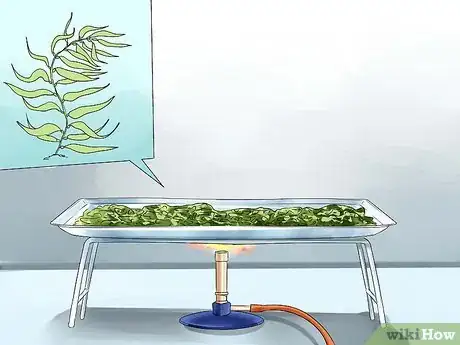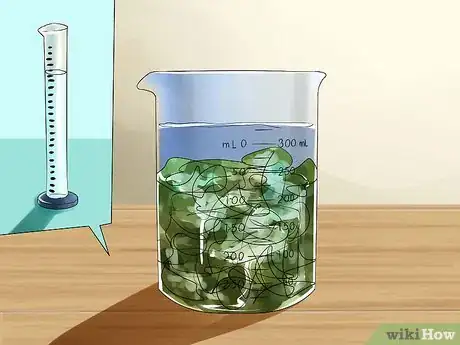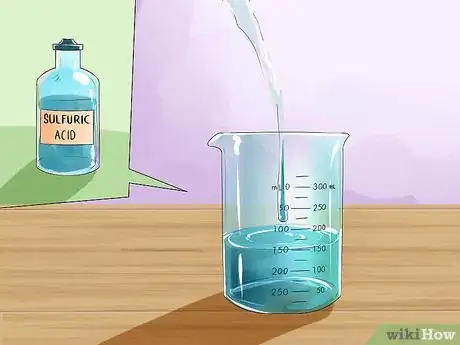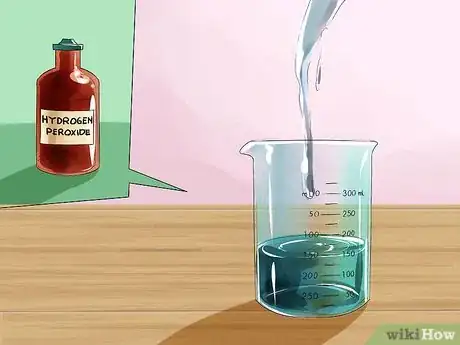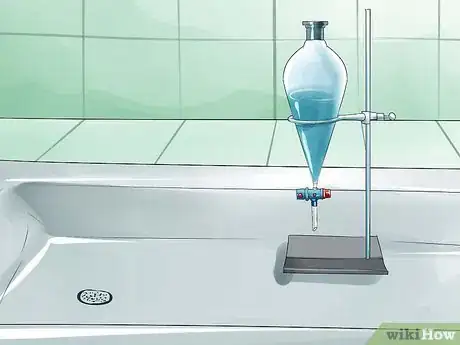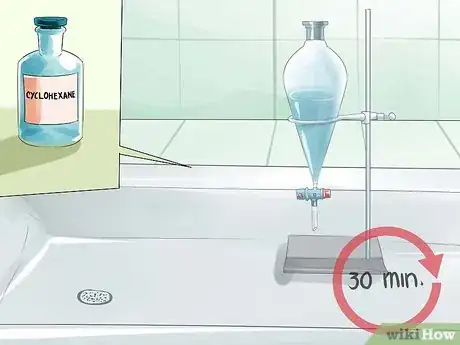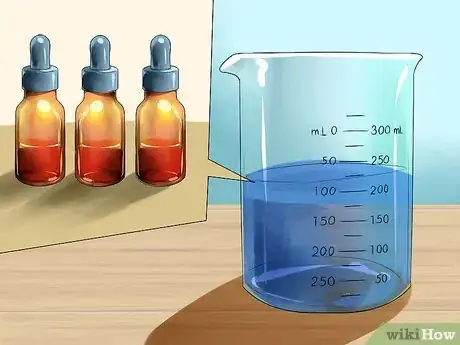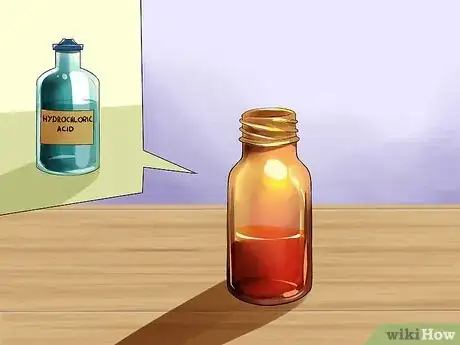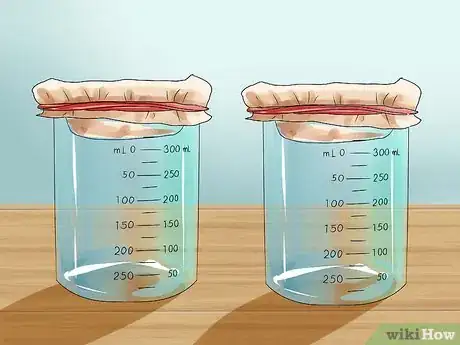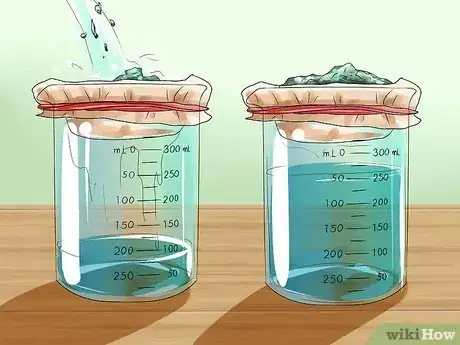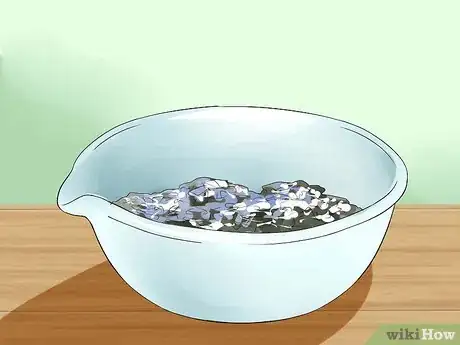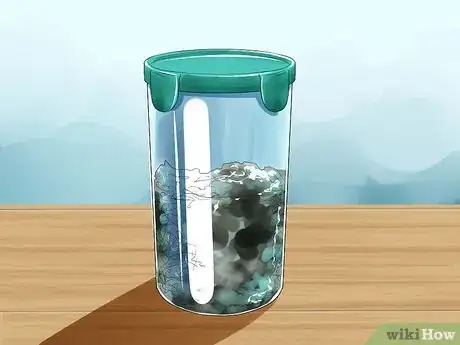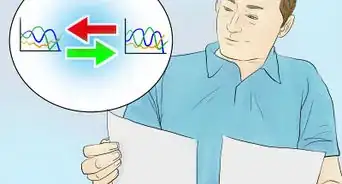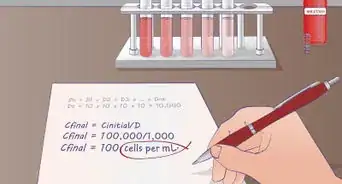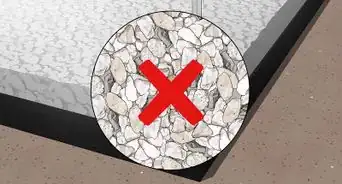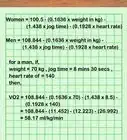X
wikiHow is a “wiki,” similar to Wikipedia, which means that many of our articles are co-written by multiple authors. To create this article, 18 people, some anonymous, worked to edit and improve it over time.
This article has been viewed 53,552 times.
Learn more...
Iodine is a dark-gray to purple-black, lustrous, solid element with a rhombic crystalline structure. Most often you find it in sanitizing products. Acquiring iodine in a pure form is often restricted. However, you may extract iodine from common sources. Many of the items you need can be purchased at a hardware store or online.
Steps
Method 1
Method 1 of 2:
Extracting Iodine From Kelp
-
1Prepare for the procedure. In the Things You'll Need section you will find a list of necessary items and equipment. Most of this you will be able to find at a hardware store. Some items may require shopping online. Be sure to have everything together and set out before beginning. Be sure to wear your safety gear at all times.
-
2Turn your kelp to ash.[1] A Bunsen burner and cooking tray will work well here. Cook the batch of kelp on the cooking tray above the burner. Be careful to pile the kelp so that it stays on the tray while it is cooked. Ensure proper ventilation exists as the burning process may cause enough smoke to set off an alarm.Advertisement
-
3Mix your kelp ash with purified water.[2] Measure out 20 cubic centimeters of purified water in your graduated cylinder. Pour the water into a beaker to be boiled. Remove the kelp ash from the burner. Deposit the ash into the beaker and stir.
- You will need about a dozen 50cm lengths of kelp for this step.
- Pile your kelp so that air can flow into the pile. This will help with evaporation and speed up the process.
-
4Heat your solution until it boils.[3] Put the beaker onto the Bunsen burner. Allow the solution to heat until it boils.
-
5Filter the ash from the water.[4] Place a coffee filter on top of a second beaker. Secure the filter with a rubber band. Pour the still-hot solution into the second beaker slowly. Allow time for the water to filter into the second beaker. When you are finished, remove the coffee filter and rubber band.
-
6Add sulfuric acid to the filtered water.[5] Add approximately 1 mole of diluted sulfuric acid to the filtered water. Do this very slowly to avoid splashing. Because you are using a diluted solution, splashing should have minimal effects but should be avoided nonetheless.
-
7Mix hydrogen peroxide into your solution.[6] Measure out 10 cubic centimeters of 20 volume hydrogen peroxide. This is about 1.6 moles of hydrogen peroxide. Mix the solution briefly with a stirring rod. As the hydrogen peroxide oxidizes the iodine ions you will see the solution turn brown.
- Be careful as you procure the 20 volume hydrogen peroxide. Many health and beauty stores that stock different volumes of hydrogen peroxide do so for dying hair. These hydrogen peroxide solutions may not be pure, and they may contain conditioners in addition to the hydrogen peroxide.
-
8Move your solution into a separating funnel.[7] Pour the solution from the beaker into a separating funnel. Make sure the bottom is closed off tightly. Place the separating funnel over the sink to drain with running water later.
-
9Use cyclohexane to extract the iodine.[8] Pour 10 to 20 cubic centimeters of cyclohexane into the separating funnel. Close the separating funnel with a rubber stopper in the upper opening. Shake the funnel and mixture for about 30 seconds. Replace the funnel. Remove the top stopper briefly to release any pressure. When the solution separates open the lower valve to drain off the water.
-
10Place your cyclohexane mixture into an evaporating dish and fume cupboard.[9] Pour the remaining solution into an evaporating dish. Move the dish into a fume cupboard. This will limit your exposure to toxic fumes released during evaporation. As the solution evaporates, iodine crystals will form in the evaporating dish.
- There is no need to heat the solution. The evaporation will take place properly at room temperature.
-
11Store your iodine crystals in an airtight container.[10] As soon as the solution has fully evaporated, remove the iodine crystals. Place the crystals in an airtight container promptly. If you wait too long, the iodine crystals will turn into gas (i.e., sublimate).
Advertisement
Method 2
Method 2 of 2:
Extracting Iodine From a Tincture of Iodine
-
1Prepare for the procedure. Look at the Things You'll Need section to see what you'll need for the procedure. You will find most of these items at your local hardware store. However, you may need to do some online shopping to complete the list. Be sure to have everything together and set out before beginning. Don't forget to wear your safety gear at all times.
-
2Pour your bottles of tincture into a beaker. Use about 3 bottles. These tinctures have only a small amount of iodine. Multiple bottles are necessary for significant results. Many tinctures are only about 2% iodine.
- Do not use povidone iodine for this extraction. Extracting iodine from povidone iodine requires a different procedure than discussed in this method.
-
3Mix into your flask an equal amount of purified water.[11] Pour water into your beaker doubling the flask's initial volume. Use purified water for this step. The water will have minimal effect on the tincture so you do not need to be careful about pouring at this point. Just avoid splashing.
- Distilled water is a type of purified water. Distilled water can be used as well.
-
4Add hydrochloric acid into your mixture.> Use about 5 milliliters per bottle of tincture. Pour the mixture slowly. Fumes will begin forming while mixing. Do not inhale the fumes as they are toxic.
- Muriatic acid found in hardware stores is about 30% hydrochloric acid. This will work for this method of iodine extraction.
-
5Mix bleach with your solution.[12] Use a bleach made of sodium hypochlorite. You need about 10 milliliters of bleach per bottle of tincture. Slowly pour the bleach into the solution. Fumes will begin to form as you pour. Be careful not to inhale the fumes.
- You will see iodine crystals begin forming within the solution and settling on the bottom. Wait until there are few to no new crystals forming before filtering.
-
6Prepare your filter and storage containers. Place a pair of coffee filters on top of a different beaker. Secure them using a rubber band. Use two coffee filters instead of only one here. The acids will act on the filters, and a single filter may break.
-
7Filter your mixture through coffee filters. Pour the solution through the filter into the beaker. Pour slowly to allow the solution to drain through. When you get to the bottom, solid iodine crystals may remain in the beaker. Pour purified water into the beaker, swirl, and filter until all crystals are in the filter.
-
8Dry your crystals for a very brief time.[13] Remove the filter from the beaker. Scrape the crystals into an evaporation dish to allow them to dry. Let them dry only as long as necessary. The iodine crystals will turn into gas (i.e., sublimate) if left out.
-
9Store your iodine crystals in a small airtight container.[14] As soon as you are satisfied that your crystals are dry, move them to an airtight, glass container. Something like a test tube will work well. Use something small to reduce the amount of potential sublimation.
Advertisement
Community Q&A
-
QuestionHow do I get iodine crystals out of kelp powder?
 Community AnswerYou don't. While kelp does contain higher amounts of iodine than other plants, it still doesn't contain a lot of it.
Community AnswerYou don't. While kelp does contain higher amounts of iodine than other plants, it still doesn't contain a lot of it.
Advertisement
Warnings
- Store the iodine crystals in sealed glass containers. Other air-tight containers may stain or fail to contain the iodine.⧼thumbs_response⧽
- Always add acids to water, never the other way. Whenever acids are involved, pour very slowly.⧼thumbs_response⧽
- Work in a well ventilated area. Several mixtures release toxic fumes.⧼thumbs_response⧽
- Iodine can be very irritating to the skin. Rinse your skin well whenever you come into contact with iodine.⧼thumbs_response⧽
- Iodine may stain any surface it touches. Especially avoid contact with clothing and non-glass surfaces.⧼thumbs_response⧽
- Wear eye and skin protection. Nitrile gloves and chemical resistant goggles work well.⧼thumbs_response⧽
Advertisement
Things You'll Need
For extracting iodine from kelp
- 12 strips of 50cm Laminaria seaweed or Kelp
- Bunsen burner and fuel
- Tripod for Bunsen burner
- Fume cupboard
- Purified water
- One Graduated cylinder
- 20 cubic centimeters of Cyclohexane
- 10 cubic centimeters of 20 volume hydrogen peroxide
- Five cubic centimeters of Sulfuric acid (1 mole)
- Two 250ml beakers
- Beaker tongs or flame and heat resistant gloves
- Evaporating dish
- Separating funnel with top stopper and funnel stand
- Heat resistant mat or trivet
- Coffee filters
- Rubber band
- Evaporating dish
- Neoprene gloves
- Chemical resistant safety goggles
For extracting iodine from tincture
- Three bottles of tincture of iodine
- Purified water
- One Graduated cylinder
- Two 500ml beakers
- 30ml of bleach or sodium hypochlorite
- 15ml of muriatic acid or 30% solution of hydrochloric acid
- Coffee filters
- Rubber band
- Evaporating dish
- Neoprene gloves
- Chemical resistant safety goggles
References
- ↑ http://www.curezone.org/forums/fm.asp?i=932233
- ↑ http://www.rsc.org/learn-chemistry/resource/res00001915/extracting-iodine-from-seaweed/
- ↑ http://www.curezone.org/forums/fm.asp?i=932233
- ↑ http://www.rsc.org/learn-chemistry/resource/res00001915/extracting-iodine-from-seaweed/
- ↑ http://www.curezone.org/forums/fm.asp?i=932233
- ↑ http://www.rsc.org/learn-chemistry/resource/res00001915/extracting-iodine-from-seaweed/
- ↑ http://www.rsc.org/learn-chemistry/resource/res00001915/extracting-iodine-from-seaweed/
- ↑ http://www.rsc.org/learn-chemistry/resource/res00001915/extracting-iodine-from-seaweed/
- ↑ http://www.curezone.org/forums/fm.asp?i=932233
About This Article
Advertisement

